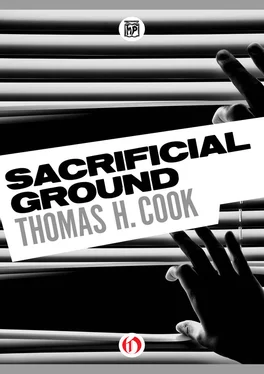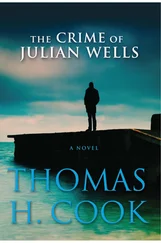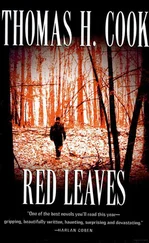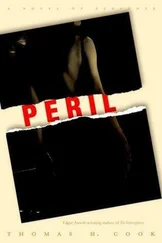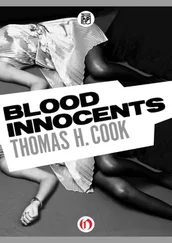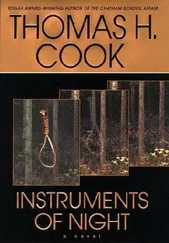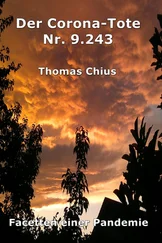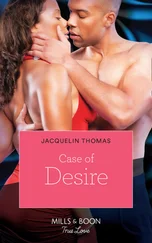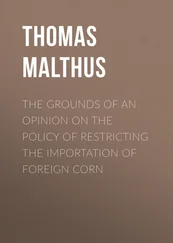“Then what?”
“She headed up this street until she got to the end of the park,” Stan told him, “then she turned left.”
“Did she turn off anywhere?” Frank asked.
Stan shook his head emphatically. “No, she went all the way down the length of the park.”
“Then what?”
“She circled the park.”
“How many times?”
“Three, I think, maybe four. I don’t know for sure.”
Frank pressed his foot slowly down on the accelerator. “All right, let’s do it,” he said.
The car veered left off Cherokee and headed down the park. At the end, Frank turned left, then at the far corner made another left.
“Now this is what she did, right?” he asked at each turn.
“That’s right.”
Frank headed down Boulevard, this time from the opposite direction, circling the park entirely.
“That’s what she did,” Stan said, as Frank eased the car onto Cherokee again.
“And she did it about three times?” Frank asked.
“That’s right.”
“Did she act like she was looking for someone?”
“No.”
“She was staring around, glancing left and right?”
“No. She kept her eyes on the road.”
“Okay,” Frank said. “What happened next?”
“She drove down into the park.”
“Where?”
“Wherever it is, if you’re trying to get down to the Cyclorama,” Stan said.
Frank drove around the park once again, then turned left down the winding road that led to the Cyclorama.
“Where did she park exactly?” he asked.
Stan pointed to the left. “Over there, by that fence,” he said.
“Facing it?”
“Yes.”
“Show me exactly.”
“Where that sign is,” Stan said. “She parked right in front of it.”
Frank eased the car into position. A huge sign all but blocked his vision. It was white with red lettering:
CYCLORAMA RESTORATION
DEPARTMENT OF PARKS
CITY OF ATLANTA
“I must have read that sign a hundred times that night,” Stan said, as Frank brought the car to a halt.
“How long did she stay here?” Frank asked.
“It’s hard to say. Maybe ten minutes. Maybe a little more.”
“You said she kept looking out her rearview mirror, is that right?”
“Yes.”
Frank glanced at his own rearview mirror. The curving road which led down to the Cyclorama was clearly visible within it.
“Did any other cars come down the road while you were here?” he asked.
“No,” Stan replied. “It was just Angelica and me.”
“You didn’t see any other light?”
“No. Nothing.”
Frank drew his eyes from the mirror and looked straight ahead. Behind the sign there was nothing but a muddy’field. He could see the discarded materials used in the restoration, piles of cement blocks, wood slats, yards of torn and rain-soaked cloth. He could see the north side of the building, blank and white, with nothing but a small door at the rear. A large pile of torn and paint-splattered drop cloths lay outside the door. Various crates and empty paint cans were scattered about the grounds, along with the jagged, broken parts of metal scaffolding. It looked like a place that had been pillaged of every scrap of value and then left to the rain.
“So you two sat here for about ten minutes,” Frank said.
“Yes.”
“Then what happened?”
“We left,” Stan said. “She floored it. I mean she peeled out of here. I remember seeing a spray of gravel thrown up behind us.”
“Peeled out?”
“Yeah, and really loud, too,” Stan said, “enough to wake the whole town up.” He motioned to the right. “She whirled around this lot and just highballed it out of the park.”
Frank hit the ignition and drove the car back up to the main road.
“Which way did she turn?” he asked.
“Left.”
Frank made the turn. “Did you circle the park again?”
“No,” Stan said. “She drove to the end of it, then she turned left and headed straight down that road.”
“Good,” Frank said. “It’s coming back.”
“I just remember going straight,” Stan said.
Frank drove on, heading the car in the way Stan had indicated. He turned left at the edge of the park, then went almost its full length, passing under a single traffic light.
“She turned here,” Stan said, pointing to the right.
Frank made a right onto Ormewood Avenue.
“She went straight, like we are now,” Stan said excitedly. “This is getting to be interesting. Is this what it’s like to be a cop?”
Frank kept his eyes locked on the road ahead. “No,” he said. He continued to move forward, passing under one traffic light, then another, until the car nosed up a small hill, and then over it.
“I remember this,” Stan said suddenly.
Frank eased his foot off the accelerator. “What?”
“We went over this hill.”
“How do you know?”
“It has a little dip at the bottom,” Stan said. “That’s where we turned.”
Frank let the car cruise slowly down the hill. He felt the dip, like something hard and blunt pressed against his belly.
“Next right! Next right!” Stan cried. He looked at Frank excitedly. “That’s the street. The one she went up and down a couple of times.”
Frank made the right turn, then stopped and looked at the street sign: Mercer Place. When he turned back to Stan, the boy’s face was pale.
“I know this is it,” he said, slowly. “She took me up and down it a couple of times. Then we went to the alley. “ He shivered slightly. “It gives me the creeps.”
Frank made a slow turn onto Mercer Place and then headed down it.
“Did she seem interested in any particular house?” he asked.
Stan shook his head. “No. She just looked straight ahead. But she did get a look in her eye, like she was forcing herself not to look one way or the other.”
“Did she say anything?”
“No.”
Frank glanced left and right as he continued to cruise slowly down the street. Small, dilapidated houses lined it. Some leaned in one direction, some in another. But all of them looked as if they were trying to let some unbearable burden slide from their shoulders at last.
It was almost midnight by the time Frank returned to his apartment. He’d gone back to the Bottom Rail for a while, just to see if it still had any appeal to him. He found that it didn’t, but he didn’t know of anything to replace it with, except a solitary drink on a soiled sofa, with his eyes locked helplessly on a square of painted flowers.
His green notebook still rested where he had left it earlier in the evening, curled up next to the bottle on the little table by the sofa. He reached for it immediately and went through it once again. Facts and suppositions swarmed in and out of his mind. He saw people and places that were real enough: Cummings and Morrison and Jameson and Theodore; offices and great halls and small, spattered studios. Karen’s portrait of Angelica came back to him, and then dissolved will-lessly into her vase of flowers. Ghosts. A city of ghosts. He thought of Linton, then of Miriam Castle, then of the little paved street that wound down from the edges of the park. He could see the storm fence, the muddy ground, the small door and mound of speckled drop cloths.
Something caught like a hook in his flesh. He sat up slowly, and all the great, teeming chaos suddenly came together in a dead and frozen order.
25
By nine o’clock the next morning, Frank was at the Cyclorama. He pulled the badge from his coat and dropped it on the desk. It gleamed like pure gold beneath the lamp.
“I’d like to see David Curtis,” he said.
“Mr. Curtis is busy at the moment,” the man said. He was wearing a blue uniform with a badge emblazoned on the front, a large tin one that carried the name of the security firm he worked for in bold letters.
Читать дальше
